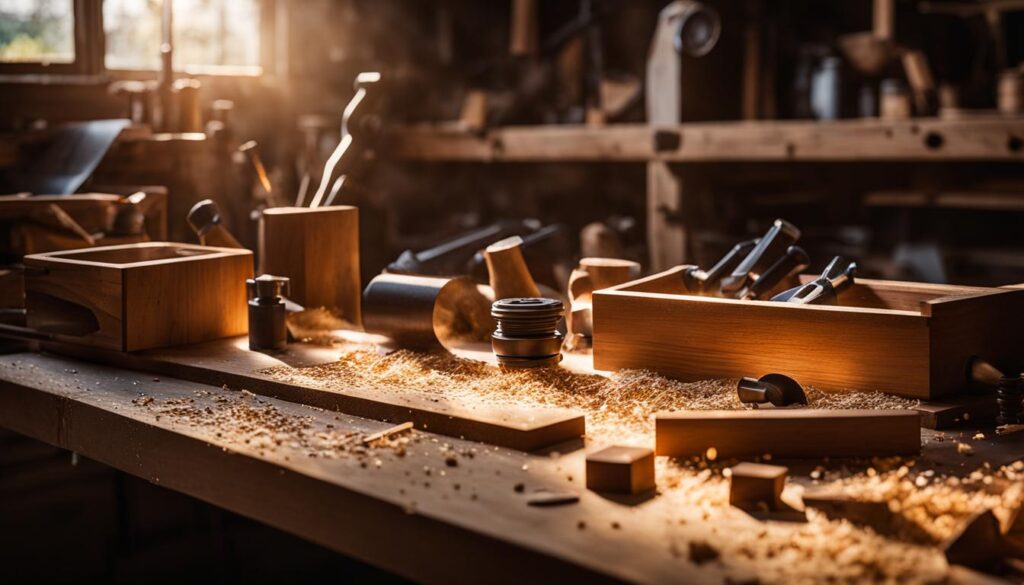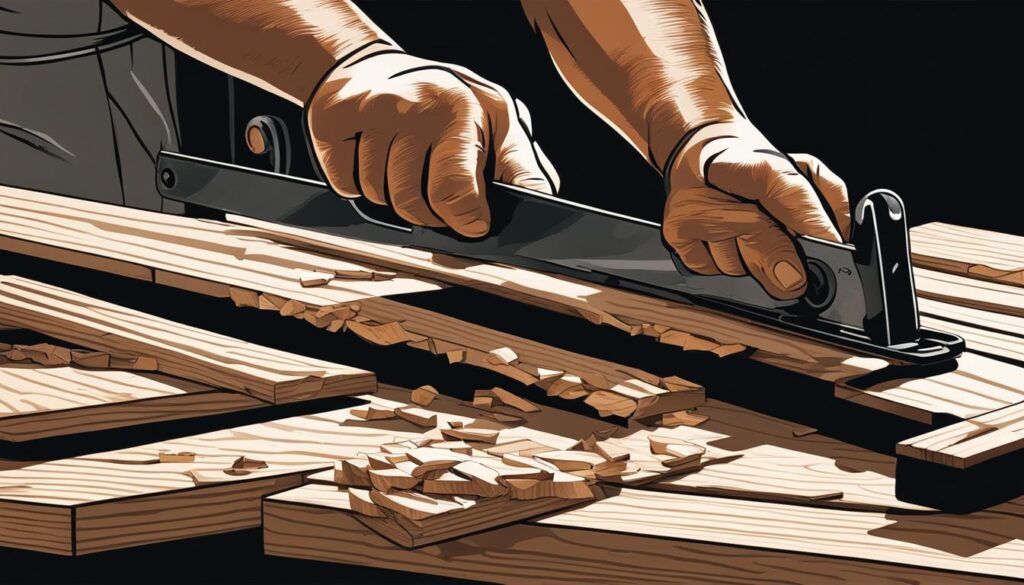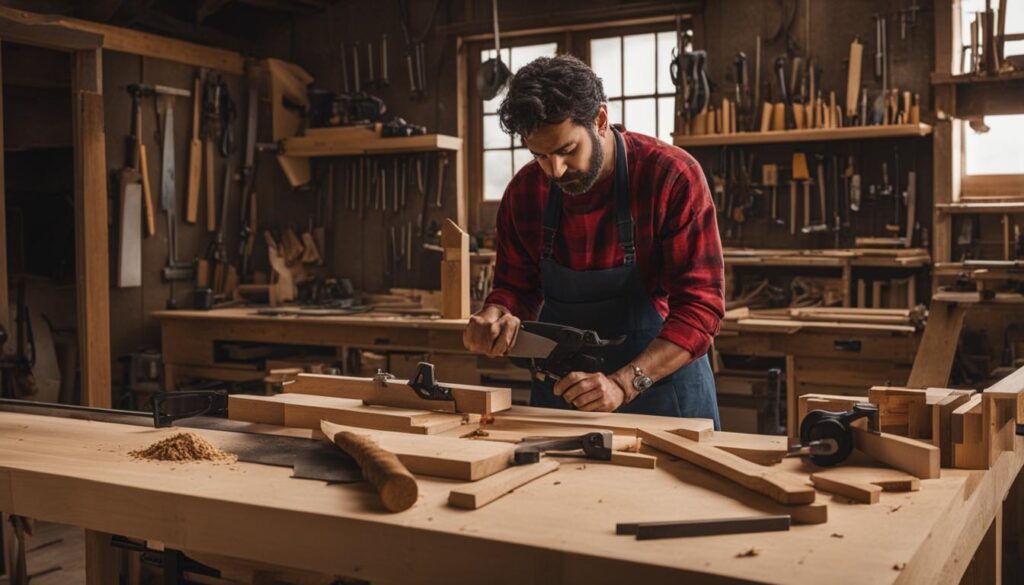We may earn money or products from the companies mentioned in this post.
Woodworking jigs and fixtures are essential tools for any woodworker, whether you’re a beginner or an expert in the craft. They help improve accuracy, efficiency, and safety in various woodworking projects, allowing you to create consistent, high-quality pieces.
This comprehensive guide will explore everything you need to know about woodworking jigs and fixtures, from understanding what they are and their importance to exploring different types of jigs and fixtures and providing step-by-step instructions for building your own. You’ll also learn how to effectively use jigs and fixtures in your projects, discover advanced techniques and tips, and enhance your woodworking skills.
Key Takeaways
- Woodworking jigs and fixtures are essential tools for improving accuracy, efficiency, and safety in woodworking projects.
- This comprehensive guide covers a range of topics, including understanding woodworking jigs and their importance, exploring different types of jigs and fixtures, building your own jigs, and effectively using jigs and fixtures in projects.
- Advanced techniques and tips, as well as how jigs and fixtures can enhance overall woodworking skills, are also covered.
- By mastering woodworking jigs and fixtures, you can elevate your craft and create consistent, high-quality pieces.
- Stay tuned for step-by-step instructions, practical examples, and useful insights that will help take your woodworking to the next level.
Understanding Woodworking Jigs and Their Importance
Woodworking is a beautiful craft that requires precision and accuracy. However, achieving these qualities can be challenging, especially when working on multiple projects with different requirements. That’s where woodworking jigs come in handy.
Woodworking jigs are specialized tools that help woodworkers achieve precise cuts and shapes, enhance efficiency, and ensure safety. They are an essential part of any woodworking project, whether you are a beginner or a pro.
Why are woodworking jigs important?
As mentioned earlier, woodworking jigs are essential tools that help woodworkers achieve precise, accurate cuts and shapes. They also enhance efficiency and ensure safety in the workshop. Below are some reasons why woodworking jigs are important:
- They help you achieve consistent results in your projects.
- They save time by speeding up the process of making repetitive cuts, shapes, or drilling holes.
- They enhance precision and accuracy by guiding your tools and workpieces in the right direction.
- They increase safety in the workshop by reducing the risk of injuries associated with making cuts without the proper guidance.
Overall, woodworking jigs are essential tools that make woodworking projects easier, safer, and more precise. Whether you are building a simple cutting jig or a complex router jig, incorporating jigs in your woodworking projects will undoubtedly lead to better quality and satisfaction.
Types of Woodworking Jigs and Fixtures
Woodworking jigs and fixtures come in various shapes and sizes, and many woodworkers prefer to build their own DIY jigs to suit specific project needs. Homemade jigs are often simple and cost-effective solutions that offer the same level of performance as commercial ones. Here are some common types of woodworking jigs and fixtures:
| Jig Type | Description |
|---|---|
| Router Jigs | These jigs are designed to guide the router along a specific path for accurately cutting grooves, mortises, and other shapes. Router jigs can be used for box joints, dovetails, tenons, and many other applications. |
| Table Saw Jigs | Table saw jigs are particularly useful for making crosscuts, angled cuts, and repeatable cuts with high accuracy. They can be used for cutting small or large workpieces and are ideal for projects like picture frames, boxes, and furniture. |
| Bandsaw Jigs | Bandsaw jigs are used for resawing wood, cutting curves, and creating intricate shapes. They can be used for making bowls, toys, decorations, and other unique pieces. Some bandsaw jigs are designed for cutting perfect circles or ellipses. |
| Drill Press Jigs | Drill press jigs are used for drilling accurate and consistent holes at specific angles and depths. They can be used for doweling, mortising, and other drilling applications. Some drill press jigs are designed to hold irregular-shaped workpieces securely. |
Other types of woodworking jigs and fixtures include sleds, clamps, guides, templates, and many more. The key to successful woodworking is to choose the appropriate jig or fixture that best suits the project at hand and follow the necessary steps for making the jig or fixture accurately.
Building Your Own Woodworking Jigs and Fixtures
Woodworking jigs and fixtures can be expensive to buy, but with some basic woodworking skills, you can easily build your own. The advantage of making your own woodworking jigs and fixtures is that you can customize them to meet your specific project requirements and save money at the same time. In this section, we will provide step-by-step instructions and tips for building your own woodworking jigs and fixtures.
Materials
The first step to building your own woodworking jig is to gather the necessary materials. The materials you will need will depend on the type of jig you are building, but some of the common materials include:
- Plywood or MDF board
- Hardwood strips or dowels
- Bolts, nuts, and washers
- Toggle clamps
Most of these materials can be found at your local hardware store or lumberyard. Once you have gathered your materials, you can begin building your jig.
Instructions
The following are general instructions for building your own woodworking jig:
- Determine the type of jig you want to build and sketch out a design.
- Cut a base from plywood or MDF board to the desired size and shape.
- Attach hardwood strips or dowels to the base using bolts, nuts, and washers to create a fence or guide for your project.
- Install toggle clamps to hold your workpiece securely in place.
- Sand and finish your jig to ensure smooth operation and prevent any snags or rough spots.
These are just general instructions, and the specifics will vary depending on the type of jig you are building. It’s essential to follow any instructions or plans carefully to ensure a functional and safe jig.
Tips
Here are some tips to keep in mind when building your own woodworking jig:
- Use a drill press or router to ensure accuracy when making holes or slots in your jig.
- Make sure your jig is square and straight to ensure accurate cuts and joints.
- Label your jigs clearly to avoid confusion and ensure they are readily identifiable.
- Test your jig before using it on a project to ensure it functions as intended.
Building your own woodworking jigs and fixtures is a fun and rewarding experience that can enhance your woodworking skills and save you money in the long run. With a little bit of time and effort, you can create jigs that are tailored to your needs and project requirements.
Using Woodworking Jigs and Fixtures in Projects
Woodworking jigs and fixtures can significantly improve the quality and precision of the projects you undertake. These tools can help take your woodworking skills to the next level, and the benefits of using them are numerous.
Examples of Projects
One of the most significant advantages of using woodworking jigs and fixtures is that they allow for better consistency when creating multiple pieces. For example, when building a set of bookshelves or drawers, using a jig can ensure that each piece fits perfectly and is identical to the others. Jigs can also help with creating intricate cuts and designs in projects, such as dovetail joints or decorative trim.
Table Saw sleds are a popular type of woodworking jig for making straight cuts and angled cuts in large pieces of wood.
| Type of Jig | Project | Benefits |
|---|---|---|
| Router Jig | Making Decorative Edges | Accurate and consistent results |
| Dovetail Jig | Joinery | Precise and strong joints |
| Table Saw Sled | Crosscutting and Ripping Large Pieces of Wood | Safe and accurate cuts |
Benefits of Using Woodworking Jigs and Fixtures
Using jigs not only helps save time but also increases accuracy, ultimately leading to better quality projects. Jigs can also reduce the risk of injury, making woodworking safer. They offer stability and hold the wood securely in place, reducing the likelihood of kickbacks and other accidents.
Another benefit of using jigs is the flexibility they provide. They can be customized to fit specific project requirements, allowing woodworkers to create unique pieces. Additionally, the use of jigs can help reduce waste by minimizing the likelihood of mistakes and misaligned cuts.
How to Use Woodworking Jigs and Fixtures
Using woodworking jigs and fixtures correctly requires careful attention to detail and adherence to safety precautions. Begin by selecting the appropriate jig for the project at hand. If making your own jig, follow instructions carefully and double-check all measurements before use.
When using a jig, position it correctly on the wood and ensure that it is securely clamped in place. Double-check that the jig is aligned correctly and that the cut or drill bit is firmly in place before beginning work.
Finally, ensure that all safety precautions are taken before using jigs and fixtures. Wear protective gear, such as goggles and ear protection, and keep your hands and fingers away from moving parts and cutting tools.
Advanced Techniques and Tips for Woodworking Jigs and Fixtures
While basic jigs and fixtures can significantly improve your woodworking projects, advanced techniques can take your craft to the next level. Here are some pro tips and tricks for using woodworking jigs and fixtures:
1. Perfect Alignment
One of the most essential aspects of using jigs is ensuring proper alignment. For instance, when using a dovetail jig, it’s crucial to set up the jig and router to achieve absolute precision. For best results, use a dial indicator to make fine adjustments and achieve perfect alignment.
2. Beyond Flat Surfaces
While jigs are commonly used for flat surfaces, they can also be effective in shaping and cutting curved surfaces. For instance, a bandsaw jig can be utilized for cutting curved parts, such as chair legs or decorative accents.
3. Customized Jigs for Specific Projects
While many jigs are commercially available, it’s often necessary to create custom jigs for specific projects. When constructing customized jigs, be sure to consider the project requirements and design a jig that will meet those specific needs.
4. Safety Precautions
As with any woodworking tool, safety precautions are critical when using jigs. Be sure to read and follow all safety instructions for each specific jig. Additionally, use push blocks and clamps to prevent injuries, and always wear protective gear, such as safety goggles and ear protection.
5. Integrating Jigs into Woodworking Plans
Integrating jigs into your woodworking plans can save time and increase accuracy. When designing projects, consider incorporating jig usage into the plans from the beginning. This approach can help ensure that the necessary jigs are created before beginning construction.
By mastering these advanced techniques and tips for woodworking jigs and fixtures, you can elevate your craft and achieve exceptional results in your woodworking projects.
Enhancing Your Woodworking Skills with Jigs and Fixtures
Woodworking jigs and fixtures can not only save time and improve accuracy but also enhance overall woodworking skills. By using jigs and fixtures, woodworkers can focus on the creative aspects of their projects without worrying about precision and consistency.
One of the key benefits of using jigs is the improvement in accuracy. Whether you are using a jig to make repeated cuts or to guide a router, the accuracy of your work will significantly improve. This, in turn, leads to improved consistency and quality in your woodworking projects.
Woodworking jigs and fixtures can also help with complicated projects. For example, if you were building a complex cabinet, you might need to make several different types of cuts. By using jigs, you can ensure that each cut is precise and consistent, making it easier to put the final pieces together.
Another advantage of using jigs and fixtures is the ability to work more efficiently. Using jigs can save time and reduce waste by streamlining the process and making it easier to repeat certain steps. This can be particularly beneficial when working on large or complex projects.
Finally, using jigs and fixtures can help improve woodworking techniques. By following the guides provided by the jigs, woodworkers can develop new skills and techniques that they can apply to future projects. This can lead to more creativity and better overall outcomes.
Overall, the benefits of using woodworking jigs and fixtures are clear. They can improve accuracy, efficiency, and consistency, as well as enhance overall woodworking skills. By incorporating jigs and fixtures into your projects, you can take your woodworking to the next level and achieve results that you never thought possible.
Conclusion
In conclusion, mastering woodworking jigs and fixtures is crucial for any woodworker who wants to elevate their craft. By using jigs, woodworkers can improve accuracy, consistency, and safety in their projects, as well as save time and effort.
Throughout this comprehensive guide, we have explored the importance of woodworking jigs and fixtures, different types of jigs, DIY options, and how to build custom jigs. We have also looked at practical examples of using jigs in woodworking projects and provided advanced techniques and tips for integrating jigs into woodworking plans.
Start Experimenting Today!
We hope this guide has inspired you to start experimenting with woodworking jigs and fixtures and discover the endless possibilities they offer. Don’t be afraid to try new things, take risks, and push your boundaries. By doing so, you will enhance your woodworking skills and create masterpieces that stand out.
Remember, using jigs is not only about making your work easier; it’s also about enjoying the process and unleashing your creativity. So, whether you are a seasoned woodworker or just starting, don’t hesitate to embrace the world of woodworking jigs and fixtures. Your projects will thank you for it!
FAQ
What are woodworking jigs and fixtures?
Woodworking jigs and fixtures are specialized tools or devices that help woodworkers achieve accurate and consistent results in their projects. They are designed to hold, guide, or support workpieces during various woodworking operations.
Why are woodworking jigs and fixtures important?
Woodworking jigs and fixtures are important because they improve accuracy, efficiency, and safety in woodworking projects. They allow woodworkers to repeat specific tasks with precision, ensuring consistent results. Jigs and fixtures also help reduce errors and minimize the risk of accidents.
What types of woodworking jigs and fixtures are there?
There are various types of woodworking jigs and fixtures depending on the specific task or woodworking operation. Some common types include router jigs, table saw jigs, bandsaw jigs, drill press jigs, and clamping fixtures. DIY and homemade jigs are also popular options.
Can I build my own woodworking jigs and fixtures?
Absolutely! Building your own woodworking jigs and fixtures is a rewarding endeavor. It allows you to customize the tools to fit your specific needs and project requirements. Many woodworkers enjoy the challenge of creating their jigs and fixtures using readily available materials.
How do I use woodworking jigs and fixtures in my projects?
Using woodworking jigs and fixtures requires proper setup and understanding of their purpose. You typically position your workpiece within the jig or fixture and secure it in place. This ensures consistent and accurate cuts, holes, or other woodworking operations. Always refer to the specific instructions or guides for each type of jig or fixture.
Are there any advanced techniques or tips for using woodworking jigs and fixtures?
Yes, there are advanced techniques and tips that can help you optimize the use of your woodworking jigs and fixtures. These include proper alignment and adjustment of the jig, ensuring the correct setup for specific tasks, and implementing safety precautions. Integrating jigs into your woodworking plans and projects can further enhance your results.
How can woodworking jigs and fixtures enhance my woodworking skills?
Woodworking jigs and fixtures can enhance your woodworking skills by improving accuracy, consistency, and overall quality in your projects. They provide a reliable and efficient way to perform repetitive tasks and achieve precise results. Using jigs and fixtures allows you to focus on the creative aspects of your woodworking while relying on the tools for enhanced precision.
Affiliate Disclosure: This post may contain affiliate links. If you purchase through our link, we may receive a small commission, but at no additional cost to you. For more information, please see our Disclosure statement.



